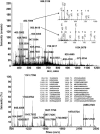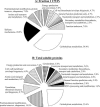Cell wall proteome in the maize primary root elongation zone. I. Extraction and identification of water-soluble and lightly ionically bound proteins
- PMID: 16377746
- PMCID: PMC1326053
- DOI: 10.1104/pp.105.070219
Cell wall proteome in the maize primary root elongation zone. I. Extraction and identification of water-soluble and lightly ionically bound proteins
Abstract
Cell wall proteins (CWPs) play important roles in various processes, including cell elongation. However, relatively little is known about the composition of CWPs in growing regions. We are using a proteomics approach to gain a comprehensive understanding of the identity of CWPs in the maize (Zea mays) primary root elongation zone. As the first step, we examined the effectiveness of a vacuum infiltration-centrifugation technique for extracting water-soluble and loosely ionically bound (fraction 1) CWPs from the root elongation zone. The purity of the CWP extract was evaluated by comparing with total soluble proteins extracted from homogenized tissue. Several lines of evidence indicated that the vacuum infiltration-centrifugation technique effectively enriched for CWPs. Protein identification revealed that 84% of the CWPs were different from the total soluble proteins. About 40% of the fraction 1 CWPs had traditional signal peptides and 33% were predicted to be nonclassical secretory proteins, whereas only 3% and 11%, respectively, of the total soluble proteins were in these categories. Many of the CWPs have previously been shown to be involved in cell wall metabolism and cell elongation. In addition, maize has type II cell walls, and several of the CWPs identified in this study have not been identified in previous cell wall proteomics studies that have focused only on type I walls. These proteins include endo-1,3;1,4-beta-D-glucanase and alpha-L-arabinofuranosidase, which act on the major polysaccharides only or mainly present in type II cell walls.
Figures





Similar articles
-
Cell wall proteome in the maize primary root elongation zone. II. Region-specific changes in water soluble and lightly ionically bound proteins under water deficit.Plant Physiol. 2007 Dec;145(4):1533-48. doi: 10.1104/pp.107.107250. Epub 2007 Oct 19. Plant Physiol. 2007. PMID: 17951457 Free PMC article.
-
Proteomics of loosely bound cell wall proteins of Arabidopsis thaliana cell suspension cultures: a critical analysis.Electrophoresis. 2003 Oct;24(19-20):3421-32. doi: 10.1002/elps.200305608. Electrophoresis. 2003. PMID: 14595688
-
Recent advances in plant cell wall proteomics.Proteomics. 2008 Feb;8(4):893-908. doi: 10.1002/pmic.200700938. Proteomics. 2008. PMID: 18210371 Review.
-
Isolation and Analysis of Cell Wall Proteome in Elsholtzia splendens Roots Using ITRAQ with LC-ESI-MS/MS.Appl Biochem Biotechnol. 2015 Jun;176(4):1174-94. doi: 10.1007/s12010-015-1638-7. Epub 2015 May 1. Appl Biochem Biotechnol. 2015. PMID: 25926012
-
Plant Cell Wall Proteomics: A Focus on Monocot Species, Brachypodium distachyon, Saccharum spp. and Oryza sativa.Int J Mol Sci. 2019 Apr 23;20(8):1975. doi: 10.3390/ijms20081975. Int J Mol Sci. 2019. PMID: 31018495 Free PMC article. Review.
Cited by
-
Plant cell wall proteomics: the leadership of Arabidopsis thaliana.Front Plant Sci. 2013 May 1;4:111. doi: 10.3389/fpls.2013.00111. eCollection 2013. Front Plant Sci. 2013. PMID: 23641247 Free PMC article.
-
Eucalyptus urograndis stem proteome is responsive to short-term cold stress.Genet Mol Biol. 2015 May;38(2):191-8. doi: 10.1590/S1415-475738220140235. Epub 2015 May 1. Genet Mol Biol. 2015. PMID: 26273222 Free PMC article.
-
MAIZEWALL. Database and developmental gene expression profiling of cell wall biosynthesis and assembly in maize.Plant Physiol. 2007 Jan;143(1):339-63. doi: 10.1104/pp.106.086405. Epub 2006 Nov 10. Plant Physiol. 2007. PMID: 17098859 Free PMC article.
-
A systematic proteomic analysis of NaCl-stressed germinating maize seeds.Mol Biol Rep. 2014 May;41(5):3431-43. doi: 10.1007/s11033-014-3205-7. Epub 2014 Apr 4. Mol Biol Rep. 2014. PMID: 24700167
-
Extraction and Characterization of Extracellular Proteins and Their Post-Translational Modifications from Arabidopsis thaliana Suspension Cell Cultures and Seedlings: A Critical Review.Proteomes. 2016 Sep 1;4(3):25. doi: 10.3390/proteomes4030025. Proteomes. 2016. PMID: 28248235 Free PMC article. Review.
References
-
- Arabidopsis Genome Initiative (2000) Analysis of the genome sequence of the flowering plant Arabidopsis thaliana. Nature 408: 796–815 - PubMed
-
- Bendtsen JD, Jensen LJ, Blom N, Von Heijne G, Brunak S (2004) Feature-based prediction of non-classical and leaderless protein secretion. Protein Eng Des Sel 17: 349–356 - PubMed
-
- Blee KA, Wheatley ER, Bonham VA, Mitchell GP, Robertson D, Slabas AR, Burrell MM, Wojtaszek P, Bolwell GP (2001) Proteomic analysis reveals a novel set of cell wall proteins in a transformed tobacco cell culture that synthesises secondary walls as determined by biochemical and morphological parameters. Planta 212: 404–415 - PubMed
-
- Borderies G, Jamet E, Lafitte C, Rossignol M, Jauneau A, Boudart G, Monsarrat B, Esquerre-Tugaye MT, Boudet A, Pont-Lezica R (2003) Proteomics of loosely bound cell wall proteins of Arabidopsis thaliana cell suspension cultures: a critical analysis. Electrophoresis 24: 3421–3432 - PubMed
-
- Boudart G, Jamet E, Rossignol M, Lafitte C, Borderies G, Jauneau A, Esquerre-Tugaye MT, Pont-Lezica R (2005) Cell wall proteins in apoplastic fluids of Arabidopsis thaliana rosettes: identification by mass spectrometry and bioinformatics. Proteomics 5: 212–221 - PubMed
Publication types
MeSH terms
Substances
LinkOut - more resources
Full Text Sources
Research Materials

